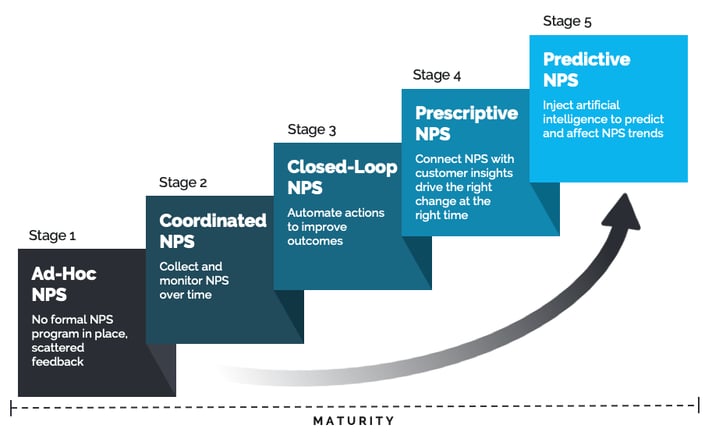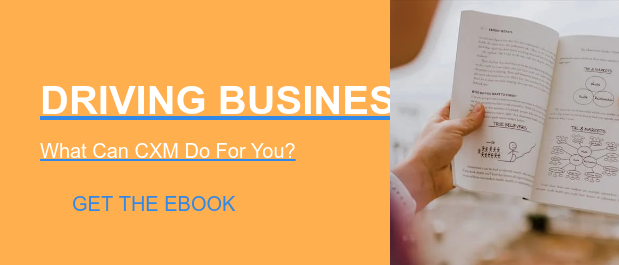A Q&A with Product Management Experts
Q: In your last post, you referred to NPS being a single stage in CXM maturity. Can you elaborate on the maturity model?
There are 5 stages of the maturity model, from informal, scattered feedback (or none at all) to a predictive approach bringing in artificial intelligence to prescribe improvement initiatives. We developed the maturity model to help our customers cut through the noise of too much customer data in too many places and move towards a state where the most important customer experience indicators are captured and used to drive the type of improvements that lead to competitive advantage.
Q: What are the stages of the maturity model?
Stage 1 is when you don't have a formal program in place. This doesn't necessarily mean you aren't surveying your customers. In fact, you might be over-surveying them with a constant stream of questions from teams across your business using a variety of tools and data formats. A heavy customer survey burden depresses response rates and can actually negatively impact the perception of your brand. I have personally received distinct surveys from a single vendor multiple times in a single day, many asking me the exact same questions. The most common reaction is to hit "unsubscribe," and that reaction alone is justification to do something differently. But there's more you need to consider. If you have a decentralized situation with no clear understanding about how customers feel about your brand, your products, your services and customer experiences, it's really hard to plan meaningful improvements - or to even recognize that they need to happen before a competitor overtakes you. Cautionary tales about defunct brands often begin this way.
Stage 2 in the maturity model is about 1) understanding the business impact you hope to achieve by implementing an NPS program 2) gaining buy-in from the stakeholders across the business to ensure the NPS feedback collected is going to materially inform and direct customer experience programs and 3) implementing the program in the right way to keep the flow of NPS feedback flowing - so you can take proactive or corrective action in an agile way.
From a practical point of view, this is the implementation of either (or both) a corporate level NPS survey and functional ones (product NPS, etc.). This stage requires integrated people, process and technology to ensure the right audience is engaged, at the right time, and the results not just make their way back into the hands of the stakeholders, but that a process exists so the stakeholders can follow-through on the comments collected from promoters and detractors. Stage 1 maturity requires a certain degree of technology sophistication - the ability to see trends over time, the ability to parse text and detect sentiment from comments shared as part of the NPS survey (beyond the score) as well as the ability to share results with business stakeholders. But it also requires buy-in from the various stakeholder groups so there is no break in the process that could devalue the program. There's nothing more frustrating than taking the time to provide feedback, only to find that nobody does anything with it. This follow-through must be operationalized or the NPS program will fail.
Stage 3 is about closing the loop on NPS scores and additional feedback provided, automating responses and other actions based on meaningful criteria specific to your business to ensure appropriate follow-up from your functional stakeholders such as the products team, customer service organization, marketing team, etc. From a technology perspective, this means taking in the NPS scores and other customer attributes and then running that data through a tailored set of rules that will determine the next step—either automated or manual. 
An example is: Detractor survey received from customer -> Processed by the rule engine which determines the customer is both a detractor and a member of a key customer segment critical to revenues -> a case is created and assigned to a customer success manager to make contact to work through the root cause of the issue OR an automated apology and special offer are sent.
The end to end workflow is managed within a single platform so customer experience leaders can see the closed-loop nature of the feedback, and identify root causes that can drive improvement programs.
Stage 4 is where you drill into the details to prescribe solutions in partnership with a connected customer insights platform - understanding not just "why" a certain NPS score was provided, but determining which specific improvements should be prioritized to change the course of the perception of your brand, products and services. At this stage of maturity, you are informed by customers who care about being heard to improve the products and services they consume from your brand - as you decide upon and make your improvements to customer experience. Companies at this level of maturity are testing concepts and approaches with a group of well-profiled customers so they know how to meet the needs of their target customer segments, truly making the end-to-end NPS program into a competitive differentiator. This is an area where great strides have been made in recent years to better understand and engage with customers at scale using a customer insights platform - meaning companies no longer have to be reliant upon infrequent meetings of user groups or customer advisory boards where only a handful of people get to contribute. Our most mature customers are connecting these deep insights with NPS score data and the closed-loop CXM engine to drive the most informed and lowest-risk improvement programs to create a competitive advantage.
Stage 5 maturity is where the most mature organizations operate. These brands combine direct feedback (when customers talk to you) with indirect data (when customers talk about you) with inferred NPS based on look-alike modeling for known audiences. These companies bring in data from social listening tools to see how their brand is perceived by people that haven't responded directly to a survey. They ascertain where events have taken place along the customer journey that are likely to have an adverse impact on customer loyalty. They action the indirect, direct and inferred feedback in the CXM rule engine, make the known and projected NPS scores available to stakeholders, allowing them to drill into the sources of the information - and help brands predict measurable improvements to NPS that can be achieved through the implementation of recommendations offered through artificial intelligence. This level of maturity is proactive rather than reactive, and gives brands a real opportunity to inject voice of the customer into the most strategic decisions the company makes. This is what it means to truly have a pulse on customer sentiment.


